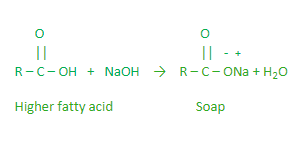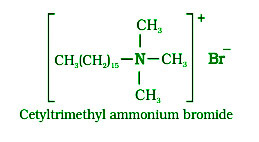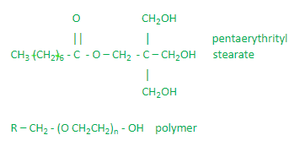清洁剂——定义、类型、性质、用途
在日常生活中,化学扮演着重要的角色。最基本的需求——住所、食物、衣服和药物——都是化学物质。有机、分析、物理、无机和生物方面在药物化学中都很重要。
化学对生活的方方面面都有直接和间接的影响。从我们呼吸的空气到吃的食物、人们居住的房屋以及每个人所经历的情感,化学在日常生活中起着至关重要的作用。药剂师制作人们生病时服用的药物。消化、叶子褐变和漂浮在水上的冰等自然现象都是基于化学原理。
清洁剂
清洁剂包括soap和清洁剂。在日常生活中,经常使用洗涤剂和肥皂来清除衣服上的污垢。Soap和清洁剂是由化学物质组成的。让我们在本文中详细研究清洁剂。 “洗涤剂”一词来自拉丁语“detergere”,意思是擦洗或清洁。然而,合成洗涤剂现在被称为洗涤剂。
肥皂
当氢氧化钠或氢氧化钾与植物或动物脂肪在皂化反应中反应时制成Soap。肥皂是包含以钾或钠为基础的长链脂肪酸的盐。就其本质而言,肥皂是水溶性的。
当酯与碱反应时发生皂化反应,从而形成醇和soap。下面是一般皂化的反应。
酯 + 碱 → 酒精 +Soap
肥皂有各种形状、颜色和香味,包括蛋糕、洗发水和奶油。肥皂是具有多于 12 个碳原子的高级脂肪酸(具有多于 12 个碳原子的脂肪酸)的钠盐或钾盐。钾制成的肥皂比钠制成的肥皂更柔软。洗发水、剃须膏和沐浴皂都含有钾皂。钠Soap是一种用于洗涤目的的soap。肥皂有两种不同的制备方法,
- 使用氢氧化钠或氢氧化钾溶液水解脂肪。

添加盐可将soap与甘油分开。由于共同的离子效应,soap从盐溶液中沉淀出来,在溶液中留下可溶于盐的甘油。
- 使用NaOH或Na 2 CO 3直接中和脂肪酸。

肥皂与这些离子反应生成不溶于水的钙盐和镁盐。

高级脂肪酸盐,例如钙和镁,不溶于水并产生粘性的灰色浮渣。结果,soap被浪费了,衣服的面料被破坏了。
Soap的种类
- 浮动肥皂:浮动肥皂是通过在它们变硬之前敲击微小的气泡而产生的。
- 香皂:它们由优质脂肪和油制成,避免使用额外的碱。为了使它们更具吸引力,添加了颜色和香味。
- 药用肥皂:防腐剂被用作各种肥皂的成分。防腐剂将有助于杀死细菌以及表面的污垢和灰尘。
- Soap和擦洗剂:肥皂包括soap、磨料(粉状浮石或细砂)和助洗剂,如碳酸钠和磷酸三钠。
- Soap片:Soap片是通过从冷却的圆筒上刮下融化的soap的小碎片而形成的。
- Soap颗粒:它们是干燥后的微小soap。
- 剃须皂:为防止快速干燥,剃须皂含有甘油。制作它们时,会添加一种称为松香的口香糖。它产生罗锌酸钠,一种发泡剂。
- 透明肥皂:它们是通过将soap溶解在乙醇中,然后蒸发剩余部分制成的。
肥皂的优点
- Soap更便宜,更广泛使用。
- 使用温和的水,它可以很好地清洁衣物(不含 Ca 2+或 Mg 2+的水)。
- 肥皂是完全可生物降解的,这意味着它们会在污水微生物中分解。因此,没有水污染。
肥皂的缺点
- 含有 Ca 2+或 Mg 2+的硬水不适用于它。
- 肥皂不能在酸性溶液中使用,因为酸会沉淀不溶性游离脂肪酸,这些脂肪酸会粘在衣服上并阻碍染色过程。
洗涤剂
合成洗涤剂是任何合成化学品,具有出色的清洁效果,可在硬水和软水中用作表面活性剂。它是一种非皂类清洁剂,通过降低水性清洁剂的表面张力起作用。
- 合成清洁剂是清洁剂的另一种形式。这些与肥皂相同,因为它们具有所有相同的品质。然而,它们不含任何soap,而且它们的化学成分与肥皂的化学成分非常不同。
- 它们适用于软水和硬水,因为它们在两者中都会产生泡沫。钙和镁盐,就像它们的钠盐一样,也是水溶性的去污剂。即使在冰冷的水中,一些洗涤剂也会产生泡沫。
- 长链醇的烷基硫酸氢盐或烷基苯磺酸盐是合成洗涤剂的常用名称。
- 肥皂和合成洗涤剂都不是完全可生物降解的,而且会污染水。
合成洗涤剂的种类
- 阴离子去污剂
链的可溶性末端具有阴离子。它们是用钠盐磺化的长链烃或醇。它们由长链碳氢化合物或醇制成,并在用 NaOH 中和之前用强硫酸处理。

清洁剂的阴离子成分有助于清洁。它们存在于整个房子的牙膏和清洁产品中。
- 阳离子洗涤剂
胺与氯化物、乙酸盐或溴化物的季铵化合物可制成阳离子洗涤剂。在链的可溶性末端,它们具有阳离子。阳离子是在氮原子上带正电荷的长链碳氢化合物,而阴离子是氯化物、乙酸盐或溴化物。它们价格昂贵并且被用作杀菌剂。
例如,护发素含有十六烷基三甲基氯化铵。因此,烷基铵盐是阳离子去污剂。

- 非离子洗涤剂
它们没有任何离子。当硬脂酸和聚乙二醇结合时,会产生一种去污剂。非离子洗涤剂是液体餐具洗涤剂。就清洁活性而言,这种洗涤剂的作用方式与肥皂相同。胶束的形成也有助于消除油脂和油。使用洗涤剂的主要问题是细菌不能轻易分解具有高度支化烃链的洗涤剂。

其中 R 是 11-17 个碳原子的链,n = 8 到 12。它们主要用于容器清洁。所有这些洗涤剂的工作方式与肥皂的工作方式相同。
当硬脂酸与聚乙二醇结合时,会产生非离子洗涤剂。

洗洁精的优点
- 粉状洗涤剂效果很好。
- 这些试剂可以软化水并提高洗衣粉的效率。
- 它们还可以防止soap渣和不溶性盐从你的衣服上掉下来。
- 这些助洗剂将油和油脂分解成衣服表面的小块。
洗洁精的缺点
- 洗涤剂的主要缺点是不可生物降解。
- 它们污染土壤和水。
- 有些洗涤剂含有过多的碱,会导致织物损坏。
- 使用较便宜的洗涤剂时,颜色可能会褪色。
洗涤剂污染
洗涤剂中的支链烃链会污染湖泊、池塘、河流和其他水体。防止细菌攻击和破坏链的侧链的存在解释了这一点。结果,去污剂分子会缓慢降解,并在表面积聚。
Soap的清洁作用机制
soap分子由两部分组成:一个可溶于油的长碳氢化合物尾部和另一个可溶于水的组分。

当soap中的碳氢化合物元素被引入布的油腻或油腻部分时,它会溶解在油中,从而使头部远离油。通过将大分子的油和soap分子在水中摩擦成小的乳化油滴,大分子的油和soap被分解。水流冲走微小的乳化油滴。乳液阴离子相互抵抗,因此不会发生沉积。它是油和水的乳液。在清洁方面,Soap和清洁剂的工作方式相同。
硫酸钠、无机磷酸盐、过硼酸钠、发泡剂和其他添加剂构成了商业洗涤剂中剩余 20% 的活性化学品。洗涤剂中的磷酸盐有助于藻类和杂草在水中的生长,消耗海洋动物的氧气。因此,合成洗涤剂会造成水污染。
肥皂和洗涤剂的区别 Example: Sodium palmitate. Example: Deoxycholic acid.Soaps Detergents In hard water and saline water, they are ineffective. In hard water and saline water, they retain their effectiveness. Biodegradable soaps are available. Non-biodegradable detergents have a branching hydrocarbon chain. Natural sources, such as vegetable oils and animal fats, are used to make them. Synthetic derivatives are detergents. In a hard water setting, they have a proclivity to produce scum. Scum does not form as a result of these chemicals. Because soap is biodegradable, it is an environmentally friendly product. These substances can combine to generate a thick foam, which can kill aquatic life.
概括
Cleaning agents include soaps and detergents. Soaps are sodium or potassium salts of fatty acids with a greater fatty acid content. Sodium salts of alkyl hydrogen sulphates and sodium salts of long chain alkyl benzene sulphonic acids are used to make detergents. Soaps and detergents are made from emulsified oil droplets that are subsequently rinsed away by a stream of water.
概念问题
问题1:肥皂和洗涤剂是基本的,不是吗?
回答:
Soaps are sodium or potassium-based fatty acid salts that dissolve in water. Soaps are created by chemically processing fats and oils, or their fatty acids, with a strong alkali. Salts are detergents and soaps. As a result, they have very basic features and can be classified as salts.
问题2:Soapv/s洗涤剂:有什么区别?
回答:
Soaps are carboxylic acid salts with long chains of sodium. Detergents are sodium salts of benzene sulphonic acids with a lengthy chain. Some detergents cannot be biodegraded, although soaps can. Soaps have a modest cleaning activity compared to detergents, which have a strong cleaning action.
问题 3:皂化程序是否适用于所有soap?
答案:
The saponification technique is used to make soap. The method and kind of soap, such as detergent, toilet soap, and detergent bar, are the only differences in the procedure. These soaps have distinct reactants, hence their products are different, but their derivatives, which are metal salts of fatty acids, are the same.
For Example:
- Sodium salt of fatty acids is used as a detergent.
- Soap is a fatty acid potassium salt.
问题4:因为soap含有碱,为什么我们切洋葱后要涂?
答案:
Onions contain a sulphur – containing component that breaks down into sulphuric acid when hydrolyzed. As a result, when we wash our hands with soap, the sulphur impurity is neutralized and removed from our hands.
问题5:如何使用洗涤剂帮助清洗脏衣服?
答案:
When soap is dissolved in water, the hydrophobic ends of the soap attach to dirt and lift it off the cloth. To begin, soap molecules create micelles, trapping dirt in the cluster’s center. Like particles in a colloidal solution, these micelles remain suspended in water.
Because of ion-ion repulsion, the different micelles present in water do not come together to create a precipitate. As a result, dust particles are caught in micelles (which stay suspended) and readily washed away with water.
As a result, soap micelles dissolve dirt in water and remove it.
问题6:解释肥皂的优缺点?
答案:
- Advantages of Soaps
- Soap is less expensive and more widely available.
- With gentle water, it cleans garments well ( Water which doesn’t contain Ca2+ or Mg2+ ).
- Soaps are completely biodegradable, meaning they breakdown in sewage microorganisms. As a result, there is no pollution of water.
- Disadvantages of Soaps
- Hard water with Ca2+ or Mg2+ does not work well with it.
- Soaps can’t be used in acidic solutions because the acids precipitate the insoluble free fatty acids, which stick to the clothes and impede the dyeing process.
问题7:解释洗涤剂的缺点?
答案:
Disadvantages of Detergents
- Detergents have the primary drawback of not being biodegradable.
- They pollute the soil and water.
- Some detergents contain too much alkali, which can cause fabric damage.
- When using a less expensive detergent, the colour may fade.
多项选择题
问题1:Soap的配方?
- C 17 H 35 COONa
- C 19 H 35 COONa
- C 17 H 33库纳
- C 19 H 33库纳
答案:
- C17H35COONa
问题2:冷加工过程中油脂皂化使用哪种溶液?
- 氢氧化钠
- 氢氧化钾
- 盐酸
- 氯化钠
答案:
2. KOH
A KOH solution is used to saponify a fat or oil in the cold process. A soft soap is created when potassium hydroxide (KOH) is utilized. It is not suitable for usage in harsh water.
问题3:在热过程中皂化脂肪或油使用哪种溶液?
- 氢氧化钠
- 氢氧化钾
- 盐酸
- 氯化钠
答案:
- NaOH
A heated method is used to saponify a fat or oil using NaOH solution. With NaOH in water, saponification of myristic acid to the sodium salt takes place. Hard soaps are created by using sodium hydroxide (NaOH).
问题4:肥皂和合成洗涤剂都不是完全可生物降解的,会污染水。
- 真的
- 错误的
回答:
- True